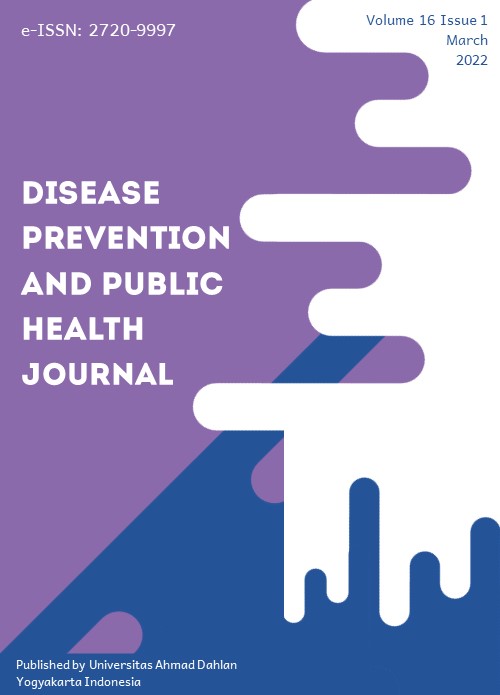Synchronization of Codification of Unspecified Schizophrenia Againts Back-Referral System of Mirit Public Health Center
DOI:
https://doi.org/10.12928/dpphj.v16i1.4678Keywords:
Synchronization, Back-Referral System, Codification, SchizophreniaAbstract
Background: The disease classification system is a grouping of diseases following the International Statistical Classification of Diseases and Related Health Problems Tenth Revisions ICD-10. The coding application must be in accordance with ICD-10 to obtain a valid code in disease indexing, national, international reporting of morbidity and mortality, analysis of health care costs, and epidemiological and clinical research. The diagnosis of schizoaffective disorder is made if schizophrenia and affective disorder are symptoms based on the ICD-10 diagnostic criteria. This study aims to determine the synchronization of the codification of unspecified schizophrenia and determine the factors that influence it against the back-referral system at the Mirit Health Center. Method: This research is qualitative research with a descriptive approach. Respondents were four officers, i.e. one doctor, one medical record officer, one person holding a mental program, one pharmacy officer. The number of observed medical record documents was 96 data with research indicators of accuracy and completeness of the diagnosis code in patients referred from First Level Health Facilities (FKTP) to Advanced Health Facilities (FKTL). Result: The results showed 30 referrals, with nine referrals having the accuracy of the patient referral diagnosis code. The back-referral program (PRB) for mental illness at the Mirit Health Center, in collaboration with Mbah Marsio's mental health rehabilitation center, was carried out well. However, the implementation of the Chronic Disease Management program (Prolanis) for mental health was still not good. Conclusion: There are many unsynchronized codifications. It is recommended to conduct an evaluation where they communicate with each other about the patient's condition to supervise the implementation of Referback Patients, especially to specialists who write the back-referral form.
References
Chen, X., Tong, Y., Shi, Z., Chen, H., Yang, Z., Wang, Y., Chen, L., & Yu, J. (2019). Noninvasive Molecular Diagnosis of Craniopharyngioma with MRI-Based Radiomics Approach. BMC neurology, 19(1), 6. https://doi.org/10.1186/s12883-018-1216-z
Keshavan, M. S., Collin, G., Guimond, S., Kelly, S., Prasad, K. M., & Lizano, P. (2020). Neuroimaging in Schizophrenia. Neuroimaging clinics of North America, 30(1), 73–83. https://doi.org/10.1016/j.nic.2019.09.007
Silva, M. A., & Restrepo, D. (2019). Functional Recovery in Schizophrenia. Recuperación funcional en la esquizofrenia. Revista Colombiana de psiquiatria (English ed.), 48(4), 252–260. https://doi.org/10.1016/j.rcp.2017.08.004
Mamakou, V., Thanopoulou, A., Gonidakis, F., Tentolouris, N., & Kontaxakis, V. (2018). Schizophrenia and Type 2 Diabetes Mellitus. Psychiatrike = Psychiatriki, 29(1), 64–73. https://doi.org/10.22365/jpsych.2018.291.64
Vita, A., & Barlati, S. (2018). Recovery From Schizophrenia: Is It Possible?. Current opinion in psychiatry, 31(3), 246–255. https://doi.org/10.1097/YCO.0000000000000407
Palomar-Ciria, N., Cegla-Schvartzman, F., Lopez-Morinigo, J. D., Bello, H. J., Ovejero, S., & Baca-García, E. (2019). Diagnostic Stability of Schizophrenia: A systematic review. Psychiatry research, 279, 306–314. https://doi.org/10.1016/j.psychres.2019.04.020
Hosak, L., Sery, O., Sadykov, E., & Studnicka, J. (2018). Retinal Abnormatilites as a Diagnostic or Prognostic Marker of Schizophrenia. Biomedical papers of the Medical Faculty of the University Palacky, Olomouc, Czechoslovakia, 162(3), 159–164. https://doi.org/10.5507/bp.2018.035
Jaaro-Peled, H., & Sawa, A. (2020). Neurodevelopmental Factors in Schizophrenia. The Psychiatric clinics of North America, 43(2), 263–274. https://doi.org/10.1016/j.psc.2020.02.010
Emengo, V. N., Williams, M. S., Odusanya, R., Uwemedimo, O. T., Martinez, J., Pekmezaris, R., & Kim, E. J. (2020). Qualitative Program Evaluation of Social Determinants of Health Screening and Referral Program. PloS one, 15(12), e0242964. https://doi.org/10.1371/journal.pone.0242964
Davis, J. M., Thomas, L. C., Dirkes, J. E., Datta, S. K., & Dennis, P. A. (2020). Comparison of Referral Methods Into A Smoking Cessation Program. Journal of comparative effectiveness research, 9(11), 807–815. https://doi.org/10.2217/cer-2020-0004
Zhu, E., Ahluwalia, J. S., & Laws, M. B. (2020). An Evaluation of Connect for Health: A Social Referral Program in RI. Rhode Island medical journal (2013), 103(5), 65–69.
Barth, C., Colombet, I., Montheil, V., Huillard, O., Boudou-Rouquette, P., Tlemsani, C., Alexandre, J., Goldwasser, F., & Vinant, P. (2020). First Referral to an Integrated Onco-Palliative Care Program: A Retrospective Analysis of Its Timing. BMC palliative care, 19(1), 31. https://doi.org/10.1186/s12904-020-0539-x
Venkataramani, M., Pollack, C. E., Yeh, H. C., & Maruthur, N. M. (2019). Prevalence and Correlates of Diabetes Prevention Program Referral and Participation. American journal of preventive medicine, 56(3), 452–457. https://doi.org/10.1016/j.amepre.2018.10.005
Berry, C., Paul, M., Massar, R., Marcello, R. K., & Krauskopf, M. (2020). Social Needs Screening and Referral Program at a Large US Public Hospital System, 2017. American journal of public health, 110(S2), S211–S214. https://doi.org/10.2105/AJPH.2020.305642
Jarczyk, K. S., Pieper, P., Brodie, L., Ezzell, K., & D'Alessandro, T. (2018). An Integrated Nurse Practitioner-Run Subspecialty Referral Program for Incontinent Children. Journal of pediatric health care : official publication of National Association of Pediatric Nurse Associates & Practitioners, 32(2), 184–194. https://doi.org/10.1016/j.pedhc.2017.09.015
Salam A. Sistem Pakar Diagnosa Penyakit Skizofrenia Dengan Forward Chaining Dan Bayesian Network. JOINS (Journal Inf Syst. 2021;6(1):72–82.
Nørgaard, H., Schou Pedersen, H., Fenger-Grøn, M., Vestergaard, M., Nordentoft, M., Laursen, T. M., & Mors, O. (2019). Schizophrenia and Attendance in Primary Healthcare: A Population-Based Matched Cohort Study. Scandinavian journal of primary health care, 37(3), 358–365. https://doi.org/10.1080/02813432.2019.1639927
Puspitasari, I. M., Sinuraya, R. K., Rahayu, C., Witriani, W., Zannah, U., Hafifah, A., Ningtyas, A. R., & Vildayanti, H. (2020). Medication Profile and Treatment Cost Estimation Among Outpatients with Schizophrenia, Bipolar Disorder, Depression, and Anxiety Disorders in Indonesia. Neuropsychiatric disease and treatment, 16, 815–828. https://doi.org/10.2147/NDT.S240058
Poletti, M., Gebhardt, E., Pelizza, L., Preti, A., & Raballo, A. (2020). Looking at Intergenerational Risk Factors in Schizophrenia Spectrum Disorders: New Frontiers for Early Vulnerability Identification?. Frontiers in psychiatry, 11, 566683. https://doi.org/10.3389/fpsyt.2020.566683
Hernandez-Ibarburu, G., Perez-Rey, D., Alonso-Oset, E., Alonso-Calvo, R., de Schepper, K., Meloni, L., & Claerhout, B. (2019). ICD-10-CM Extension with ICD-9 Diagnosis Codes to Support Integrated Access to Clinical Legacy Data. International journal of medical informatics, 129, 189–197. https://doi.org/10.1016/j.ijmedinf.2019.06.010
Hernandez-Ibarburu, G., Perez-Rey, D., Alonso-Oset, E., Alonso-Calvo, R., Voets, D., Mueller, C., Claerhout, B., & Custodix, N. V. (2019). ICD-10-PCS Extension with ICD-9 Procedure Codes to Support Integrated Access to Clinical Legacy Data. International journal of medical informatics, 122, 70–79. https://doi.org/10.1016/j.ijmedinf.2018.11.002
Glerum, K. M., & Zonfrillo, M. R. (2019). Validation of an ICD-9-CM and ICD-10-CM Map to AIS 2005 Update 2008. Injury prevention : journal of the International Society for Child and Adolescent Injury Prevention, 25(2), 90–92. https://doi.org/10.1136/injuryprev-2017-042519
Karimah RN, Setiawan D, Nurmalia PS. Diagnosis Code Accuracy Analysis Of Acute Gastroenteritis Disease Based on Medical Record Document in Balung Hospital Jember. J Agromedicine Med Sci. 1970;2(2):12.
Kelley, A. S., Ferreira, K. B., Bollens-Lund, E., Mather, H., Hanson, L. C., & Ritchie, C. S. (2019). Identifying Older Adults With Serious Illness: Transitioning From ICD-9 to ICD-10. Journal of pain and symptom management, 57(6), 1137–1142. https://doi.org/10.1016/j.jpainsymman.2019.03.006
Hess, L. M., Zhu, Y. E., Sugihara, T., Fang, Y., Collins, N., & Nicol, S. (2019). Challenges of Using ICD-9-CM and ICD-10-CM Codes for Soft-Tissue Sarcoma in Databases for Health Services Research. Perspectives in health information management, 16(Spring), 1a.
Mayssara A. Abo Hassanin Supervised A. Tono. Pap Knowl Towar a Media Hist Doc. 2018;4:49–59.
Karimah RN, Setiawan D, Nurmalia PS. Diagnosis Code Accuracy Analysis Of Acute Gastroenteritis Disease Based on Medical Record Document in Balung Hospital Jember. Vol. 2, Journal of Agromedicine and Medical Sciences. 1970. 12 p.
Cai, C. X., Michalak, S. M., Stinnett, S. S., Muir, K. W., Fekrat, S., & Borkar, D. S. (2021). Effect of ICD-9 to ICD-10 Transition on Accuracy of Codes for Stage of Diabetic Retinopathy and Related Complications: Results from the CODER Study. Ophthalmology. Retina, 5(4), 374–380. https://doi.org/10.1016/j.oret.2020.08.004
Zhou, L., Cheng, C., Ou, D., & Huang, H. (2020). Construction of a semi-automatic ICD-10 coding system. BMC medical informatics and decision making, 20(1), 67. https://doi.org/10.1186/s12911-020-1085-4
Journal U, Wulandari PA, Piksi P, Bandung G, Barat J. Analysis Of Accuracy Of Cjs Patient Diagnosis Code In Buayan Health Center On The Outdoor Diagnosis Of Pku Muhammadiyah Gombong. 2021;2(2):6–10.
Downloads
Published
Issue
Section
License
Copyright (c) 2021 Universitas Ahmad Dahlan

This work is licensed under a Creative Commons Attribution-ShareAlike 4.0 International License.
Authors transfer the copyright and grant the Disease Prevention and Public Health Journal right of first publication with the work simultaneously licensed under a Creative Commons Attribution License (CC BY-SA 4.0) that allows others to share (copy and redistribute the material in any medium or format) and adapt (remix, transform, and build upon the material) the work for any purpose, even commercially with an acknowledgement of the work's authorship and initial publication in Disease Prevention and Public Health Journal. Authors are able to enter into separate, additional contractual arrangements for the non-exclusive distribution of the journal's published version of the work (e.g., post it to an institutional repository or publish it in a book), with an acknowledgement of its initial publication in Disease Prevention and Public Health Journal. Authors are permitted and encouraged to post their work online (e.g., in institutional repositories or on their website) prior to and during the submission process, as it can lead to productive exchanges, as well as earlier and greater citation of published work (See The Effect of Open Access).

This work is licensed under a Creative Commons Attribution-ShareAlike 4.0 International License.







